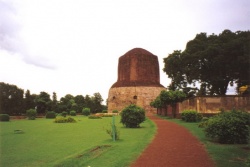Deer Park
Deer Park
鹿野苑 (Skt Mrigadava; Pali Migadaya; Jpn Rokuya-on) Site of the first turning of the wheel of Dharma where the Buddha gave His first sermon on the Four Noble Truth at Isipatana (Sarnath) near Bernares (Varanasi). One of the four pilgrimage sites mentioned in the Mahaparinibbana Sutta
A park in Varanasi in India, the site of present-day Sarnath. Deer Park was also known as Rishipatana (Skt; Pali Isipatana), or Sage Ascetics-Gathering. Here Shakyamuni delivered his first sermon. The Sanskrit word mriga of Mrigadava means deer, and dava means forest. Rishi of Rishipatana means sage, saint, ascetic, or hermit, and patana means gathering, falling, or descending. According to the Miscellaneous Agama Sutra, after his awakening under the bodhi tree, the Buddha went to Deer Park where he delivered his first sermon on the four noble truths and converted the five ascetics. Hsüan-tsang's Record of the Western Regions explains the origin of the name Deer Park.
According to this work, the lord of Varanasi once hunted and killed many deer on this land. The deer population was presided over by a deer king, who implored the lord to stop the unnecessary killing and in turn promised that each day he would give the lord the number of deer that he required. One day the deer king was faced with the necessity of sending a pregnant doe. Rather than sacrifice her with her unborn fawn, the deer king went to the lord to offer his own flesh instead. The lord was so moved by the deer king's compassion that he gave him the land. Hence it was named Deer Park. Varanasi prospered until the Muslim invasion in the thirteenth century. Stupas and monasteries were built in this area, where Buddhist believers came to visit. In modern times, ruins have been discovered here, including one of King Ashoka's stone pillars topped by a sculpture of a lion.
See also: Sarnath
